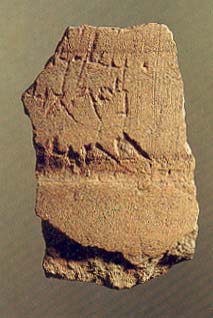Image Details

Zev Radovan, courtesy of Ephraim Stern
“Melekna[tan] … servant of Esh[mun … ]” says the fragmentary Phoenician inscription on this ostracon (inscribed potsherd) from the late sixth century B.C.E. Found in a residence in excavation area C, the ostracon may have belonged to a servant of Eshmun’ezer, the king of Sidon. In any case, Eshmun is a theophoric element in the name that refers to the principal Sidonian god. This, in conjunction with other evidence, indicates that Sidon administered Dor on behalf of the Persians from the late sixth century B.C.E. until its conquest by Alexander the Great in the fourth century B.C.E.
